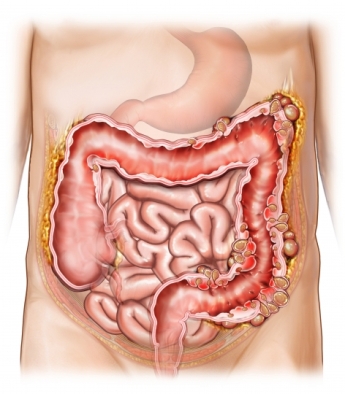Diverticulitis – Acute diverticulitis – Acute intestinal diverticulitis
Description diverticulitis
Pouch, which is formed in the wall of the colon, called diverticula. Diverticulitis occurs, When it becomes infected or inflamed.

Reasons for diverticulitis
While the reasons are not clear, because that form diverticula. Doctors believe, when food moves too slowly through the intestines, This creates a constant pressure. This pressure increases and pushes against the walls, creating bags (dyvertykulы). Digested food or stool can get into one of the pouches. This leads to inflammation and infection.
The appearance may contribute to diverticulitis :
- Foods low in fiber – It softens the stool and the food is sometimes not enough to digest;
- The increased pressure in the gut when the chair is difficult;
- Defects in the wall of the colon;
- Chronic constipation.
Risk factors
Factors, which increase the likelihood of diverticulitis:
- Foods low in fiber;
- Age: 50 and older;
- Previous cases of diverticulitis;
- Foods rich in meat protein, or;
- Chronic constipation.
Symtomы diverticulitis
Symptoms can come on suddenly. They vary depending on the degree of infestation.
Symptoms include:
- Abdominal pain;
- Soreness, usually, in the left lower abdomen;
- Swollen and hard abdomen;
- Heat;
- Chills;
- Poor appetite;
- Nausea;
- Vomiting;
- Diarrhea;
- Constipation;
- Diarrhea and constipation alternately;
- Spasms;
- Rectal bleeding.
Diagnosis of diverticulitis
At the initial stage provola physical examination and a rectal examination.
Early detection of disease is very important. Diverticula can burst and intestinal contents fall into the abdominal cavity. This will require emergency surgery, To avoid infection,.
Make an analysis, which may include:
- An analysis of stool samples for the presence of blood;
- Blood tests for the presence of symptoms of infection, inflammation, and bleeding;
- X-ray examination, to find the gap;
- CT scan or ultrasound examination, to determine the location and size of the inflamed diverticulum.
Once the inflammation passes, performed other tests:
- A barium enema – injection of a radiopaque substance into the rectum, which makes the intestines visible on x-ray and allows you to see the places of pathologies;
- Flexible sigmoidoscopy – camera in a thin tube into the rectum vstavlyaetsyaa, and to investigate its colon, box below;
- Colonoscopy – Camera in a thin tube is inserted through the rectum into the colon, to explore the surface.
Treatment for diverticulitis
Treatment includes:
Medications
Antibiotics and other drugs are being taken to fight infection. Analgesics are designed to reduce the pain in the abdomen.
Liquids
With a slight inflammation of the recommended diet of liquid foods. In more severe cases, the liquid with nutrients administered intravenously. If nausea and vomiting, plastic tube may be inserted through the nose into the stomach contents to drain.
Preventive Care
Changes in diet can help prevent attacks of diverticulitis:
- Nebhodimo increase the amount of fiber in the diet, consumption of fruit, vegetables and whole grains;
- Avoid laxatives, enemas, and, on the other hand, supplementation, that can lead to constipation.
Surgical treatment
Surgery to remove part of the colon with bags may be recommended, if:
- There have been several attacks in two years;
- Diverticulum bursts, and contents into the peritoneal cavity (required cleaning of the abdominal cavity);
- At step removes part bowel disease. Healthy parts are held together.
Surgery is also used to treat complications of diverticulitis, such as:
- Abscess – It is, If an infected diverticulum fills with pus;
- Bowel obstruction – scar tissue, which blocks the movement of food through the intestines or feces;
- Fistula (CVIS) – appears, If the infection spreads from the intestines to other organs, eg, mochevogy bladder or the uterus / vagina.
When surgery is done on an emergency basis, the surgeon removes the diseased intestine. Because of the serious infection, the ends of the intestine are not sewn together, a time-out (colostomy). After 6-12 weeks of the stapled.
Prevention of diverticulitis
Recommendations, which may help prevent diverticulitis, improving the movement of stool and relieve constipation:
- We need to eat a balanced, high-fiber diet with plenty of fruits, vegetables and whole grains;
- Drink eight 8-ounce glasses of water each day;
- Exercise regularly.
